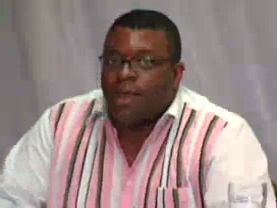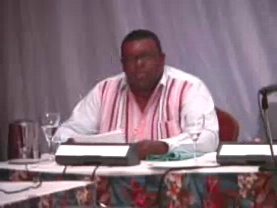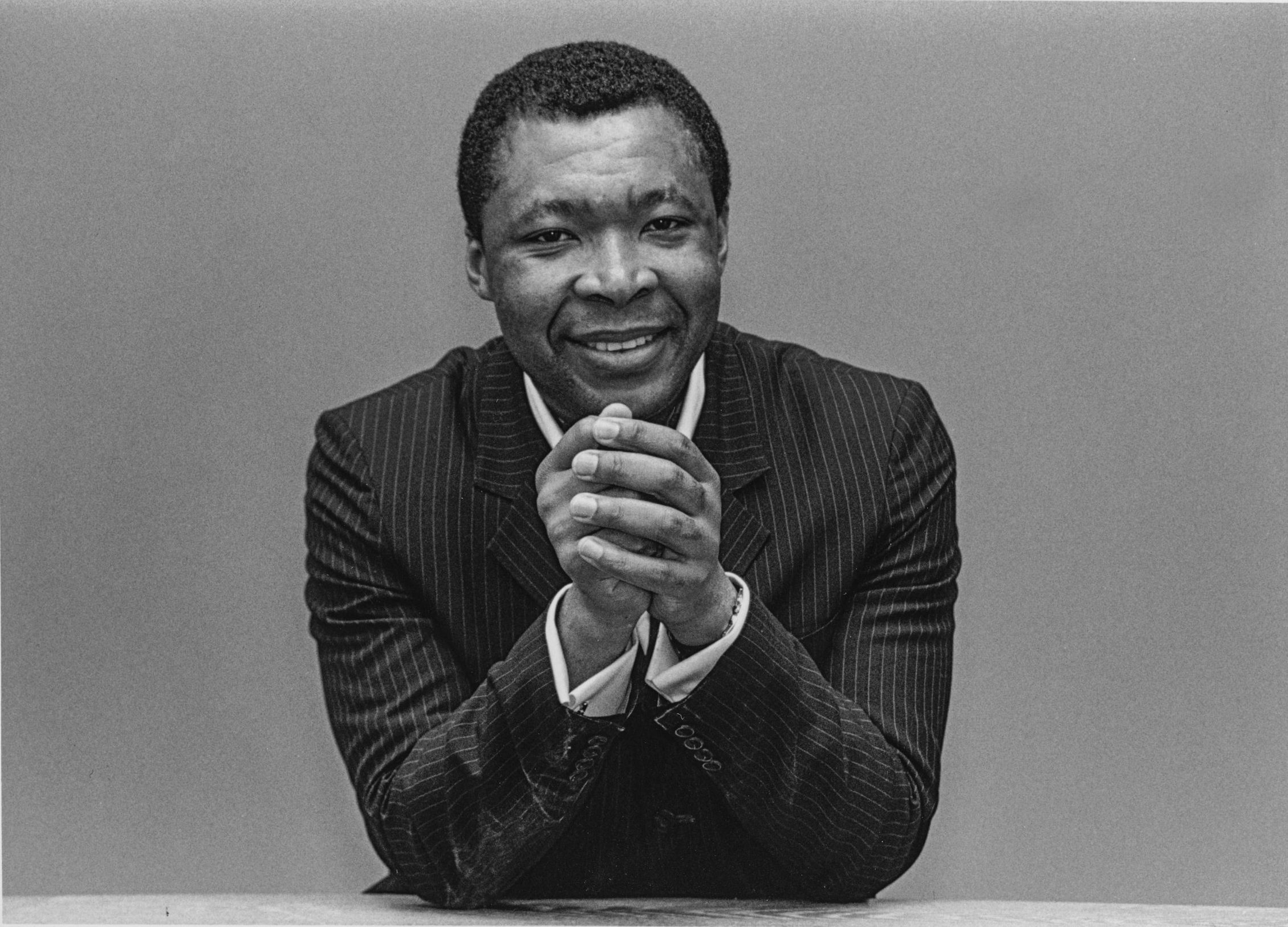Creolizing Vision
It is a great pleasure to be at this conference and workshop here in St. Lucia, which has a very significant relationship to my own personal history. As my contribution to the discussion, I will talk about some of the processes of making films and discuss in detail one of the films which utilizes Creole in its narration.
I have been making films for almost twenty years, some experimental fiction films, some documentaries, and more recently film and video installations. These films, or film essays, can be seen as a form of "traveling cinema": films which are not only set in different countries, but which involve an/other perspective. For example, Looking for Langston (1989) is substantially about the Harlem Renaissance, shot in London but obviously trying to represent 1920s New York via film archival footage/images and reconstruction. The film is also in conversation with African-American visual culture of the '20s as well as the Black Art movements of 1980s London.
Or, for example, Frantz Fanon: Black Skin, White Mask (1996), a film which I made with Mark Nash and Francoise Vergès. It was shot partially in Martinique and reconstructs North African space in a London studio setting interspersed with sequences shot in Paris and Tunisia. It also features a black British actor, Colin Salmon, as a Brechtian or Bressonian model who moves between these geographic locations. In this film, Francophone critique is brought to bear on what has become an Anglophone phenomenon, namely the advent of Fanon-mania. Stuart Hall introduces us to the complexity of Fanon's thinking, which is juxtaposed with Mohammed Harbi, an Algerian intellectual and historian who has written on the history of the FLN (Front de Libération Nationale) and was a key member during the Algerian revolution. Other visual displacements and movements are made in Fanon. Marc Garanger's identity-card photographs, which he took as a French soldier in Algeria, are front-projected onto the back of veiled women's heads, as they turn around to witness archival footage of a French battleship in Algiers, all of which are used as an image anticipating the new war of the 21st century, the war between the (Christian) West and its other, Islam.
Another film, The Darker Side of Black (1994), largely set in Jamaica, is about the misanthropic aspect of black diasporic music cultures which transverses the global circuits of dancehall, reggae, hip-hop and its discontents. This film examines the currents which flow between the circum-Atlantic transnational cities of Kingston, New York, Los Angeles, London, and back again.
In most of these films, I wanted to perform a translation not just in theoretical terms but across genre and politics, a translating of territory and temporality, a cinema which demands a self-interrogation and a translatability across the technologies of representation. From where I am, or wherever a film may be seen or shown, there will always be a different set of responses and questions. I sometimes wonder if the questions asked in each context really are that different, and as I have tried to map a new cartography, I know that I live in two places at once (London and the Americas). The global citizen is now postnational, de-national, or transnational. But I also know that through both making these films and showing them and through the lives of my own parents, who were born in St. Lucia but who have lived in London's East End for over forty years where I grew up, that uneven and unequal playing field of the global terrain has ruptured my own life, for it has been a traumatic time of transition in which many get left behind. That is what filmmaking and my personal understanding of the processes of globalization have taught me.
In Vagabondia (2000), a recent double-screen installation, I made a film in which the narration is in the Creole language that I myself grew up with, but was not encouraged to learn because my parents thought it not a "proper" language for me to speak. Vagabondia is a sort of mapping of the dislocations of language, a sort of nontranslation. The Sir John Soane's Museum in London, where the film is set, is a space in which we perceive the Empire as a precursor for globalization, buried in a showcase of the collections from around the world which it houses.

© documenta archiv / Video: documenta und Museum Fridericianum Veranstaltungs-GmbH
I would like to discuss my film practice as that of a transnational subject, a practice committed to making interventions in what has been named in other contexts as circum-Atlantic diasporic cultures. In my own practice, cinema can be a critical tool and can be used as an effective means for recirculating memory. Both Looking for Langston and Frantz Fanon are dialogues that record experiences now lost.
My practice has been an attempt at the visual archaeological expedition in transatlantic space and culture of diaspora, in effect a traveling cinema which moves against the tides of globalization. If one doesn't read against the rules of representation as they are defined by the global networks, then those rules of representation will, as it were, rewrite you.
Vagabondia, the film I would like to show to you as part of this presentation, began as a performance piece commissioned for the 1999 exhibition "Retrace Your Steps: Remember Tomorrow", curated by Hans-Ulrich Obrist and Cerith Wyn Evans and held at the Soane Museum. Thus Vagabondia collaborated in a curatorial project that produced a range of spatial occupations, in the former house and now museum of neoclassical architect Sir John Soane.1 In a way, Vagabondia is an exploration of that architectural space and an interrogation of Imperial Memory, but not in a didactic sense. I wanted to expand the phantasmatic realms of the objects on display and the jumbled and incoherent spaces they inhabit through the eyes of a black "creole" conservator, Cleo Sylvestre, a long-time collaborator, who reenacted a performance live at the museum during the exhibition opening. Vagabondia was commissioned by the Film and Video Umbrella, and the museum very kindly allowed me to film during the show itself. The Soane Museum, as cultural critic Irit Rogoff reminds me in her astute essay on the film, is "a quintessential exercise in Enlightenment", but it also can be read as a "historical precedent of postmodern eclecticism" that undoes all the "scientific illusions put forward by the traditional museum"2, which of course I like. But it is also a kind of haunted space, a cabinet of curiosities, which I used to set the scene for a trickster figure, a Hogarthian figure based on 18th-century black vagabonds of mythological repute.
I first became interested in the figure of the vagabond while looking at some rather "interesting" depictions of black beggars in Hogarth's The Rake's Progress. David Dabydeen wrote a book on the subject titled Hogarth's Blacks,3 but my reference to these rather mischievous representations is indebted to an issue of a magazine itself entitled Vagabondia, dated 1815, that I found in Gretchen Gerzina's illuminating book Black London: Life Before Emancipation.4 In that particular issue of Vagabondia, a cartoonist, John Thomas Smith, had chosen to portray in a rather amusing fashion two black London beggars notorious for their costumes. One apparently wore a grand hat that looked like a ship. I see the way that he dressed as a sort of creolized display of Empire, and in fact the movement of the trickster's dance, performed in the closing sequences of the film, his swaying from one side to another, is a translation of this nautical metaphor choreographed by Javier de Frutos. The vagabond trickster is portrayedas a restless presence in the museum, a discombobulated figure which evokes another cinematic reference that inspired his character — Jean Rouch's film Les Maîtres Fous (1955), where devotees of the Houka religion become possessed.
In Vagabondia, I wanted to visually represent several temporal planes. There is the time of the contemporaneous, which belongs to the Conservator herself, then there is a psychic time which is represented by her remembering and speaking to herself in Creole. It is these moments in the film where we see the John Soane figure along with two black 18th-century women. Another time belongs to that of the trickster character, who, in modern dress, distills the poetic notion of vagabond — a literary reference to Claude McKay's Banjo (1929). MacKay was a Harlem Renaissance writer who once described himself as a vagabond as he traveled from New York to Marseille across the Atlantic.
My intention in Vagabondia, however, is not to read these characters in a literal sense, as in a Hollywood film. They don't really act. In fact, I have always been interested in working with characters in films inspired by the way that Robert Bresson works with actors. He calls them "models". The characters or models then who are displayed in the film perform their own particular imaginary subversion of historical memory, which draws more from "performance art" than theatrical acting. The figures do not have to be read as statements, however. It is important to be able to see these characters sometimes performing independently of their indexical markers of ethnicity. They can also be interpreted as characters or models taking a space such as a museum and exploring that space, within their own search for freedom.I worked closely with the classical composer Paul Gladstone-Reid, who I commissioned to compose the score for Vagabondia. The music, for him, evoked "the ghosts of past energies who have once graced the portals of the decadently grand house of Sir John Soane, although the presence of the African and Oriental contingent may have served only to subvert the context". Gladstone-Reid continues, "The ghosts within the music seduce the latent knowing of the Conservator into a yielding posture of subconscious disclosure. The synthesis of African and Oriental soundworlds within the Occidental consciousness nurtures introspection"5. Scored for an ensemble of strings, harp, wind, piano, North African percussion, jazz, and drums, the score for Vagabondia is complemented by the narration in French Creole dialect of St. Lucia spoken by my mother Rosemary Julien. Irit Rogoff says of this: "Its language is Creole, the language of slaves and of hybrid cultures, which continues to be as barred to the contemporary visitor as it was to the slave owners of earlier centuries and it overwrites the visual puzzle of the work with an illusive and mysterious set of sounds, both poetically enticing and incomprehensible"6.
This film was shown as part of my contribution to the Turner Prize 2001 exhibition and I think it was interesting the way in which critics ignored the use of Creole in the film itself. I would argue, however, it remains only untranslatable for the noncreole subject and thus holds its own knowledge of such spaces in this piece of work itself purposefully untranslated.
Much of my work has been about the space of the museum, or has been informed by debates about how art is archived in one way or another. I have always been interested in making interventions and in looking for aesthetic strategies that take on the question of critical address and the "politics of representation", not just the representation of politics. There can be several aesthetic strategies in one piece of work and several ways to unsettle formalist aesthetic exploration, and one way to do that is in dialogue with the architectural space of the museum, which is already a site of pleasure and fantasy as well as sometimes a place of repression and desire. As Rogoff has commented: "Isaac Julien has long had an interest in the secret life of the museum and in the unusual opportunities for dreaming oneself in an alternative reality"7. An activity which is not always possible for all subjects, and certainly one in which I wanted to take the risk of doing in this piece of work.

© documenta archiv / Video: documenta und Museum Fridericianum Veranstaltungs-GmbH
Also, in Vagabondia, I wanted to use sound and movement as a form of visualization taking the structure of modern dance and performing a sort of kaleidoscopic synthesis of movement and architecture.
Now I would like to move on to this question of créolité in relationship to my own practice. While making Vagabondia, which is a collaboration of sorts with my mother, I began to think about another work that I hope to present later this year in the exhibition of Documenta11, which takes images from both islands, England and St. Lucia. I have tentatively titled the piece Paradise Omeros in homage to Derek Walcott.
In this piece, I want to explore from an adolescent's perspective the relation with the creole cultures of England and St. Lucia. A young man prepares to come to terms with a loss of innocence and at the same time the film contains an Oedipal re-reading of postcolonial and intra-ethnic relations enacted between the protagonist and the tourist/rasta male character. I also want to explore questions of racial tension translated between xenophilia and xenophobia, which is experienced by this child and his family in England, where you see scenes of enjoyment alongside ones of anguish. There are scenes in the film set in St. Lucia, quoting from Robert Mitchum's performance in Charles Laughton's The Night of the Hunter (1955) where he lectures the boy on the dynamics of love and hate, words tattooed on his outstretched fists which I translated to rings on fingers. But in reference to Derek Walcott's Omeros, I was hoping that the film would return to the Caribbean as a site of mythic cultural fantasy.
One of the principal scenes of the film is the submersion of the boy in the sea, intercut with archival sections of historical images of riot and immigration in the UK also treated in a visually immersive way. And on his journey through the sea and the archive, our protagonist falls into images of traumatic scarring. Memories, both personal and public, lead him to the metropolis, London, yet he returns to St. Lucia and back to London again through the "loop" of the film itself projected in the gallery — the oscillation effect begins as he travels back and forth in time. He had no name for the seasons, "no word for winter, for summer, for spring"8. In the West he learns a new subjectivity, the personal and psychic effects of globalization.
Isaac Julien. Creolizing Vision, in Okwui Enwezor, Carlos Basualdo, Ute Meta Bauer, Susanne Ghez, Sarat Maharaj, Mark Nash, Octavio Zaya (ed.): Créolité and Creolization. Documenta11_Platform3. Hatje Cantz Verlag, Ostfildern-Ruit. 2003, pp. 149-155.
References
1
For a review of this exhibition, see Adrian Searle, "The House That Turns Time on Its Head," The Guardian (London), December 18, 1999.
2
Irit Rogoff, "Isaac Julien's Vagabondia," in ARS 01: Unfolding Perspectives, exh. cat. (Helsinki: Museum of Contemporary Art Kiasma, 2001), p. 97.
3
David Dabydeen, Hogarth's Blacks: Images of Blacks in Eighteenth Century English Art (Mundelstrup, Denmark: Dangaroo Press, 1985).
4
Gretchen Gerzina, Black London: Life Before Emancipation (New Brunswick, N.J.: Rutgers University Press, 1995).
5
Paul Gladstone-Reid, South London Gallery press release on the exhibition "Cinerama" by Isaac Julien and Javier de Frutos, September 22—October 22, 2000, which included Vagabondia.
6
Rogoff, "Isaac Julien's Vagabondia," p. 97.
7
Ibid., pp. 97-98.
8
Quote from a poem by Derek Walcott that he wrote for the film.
